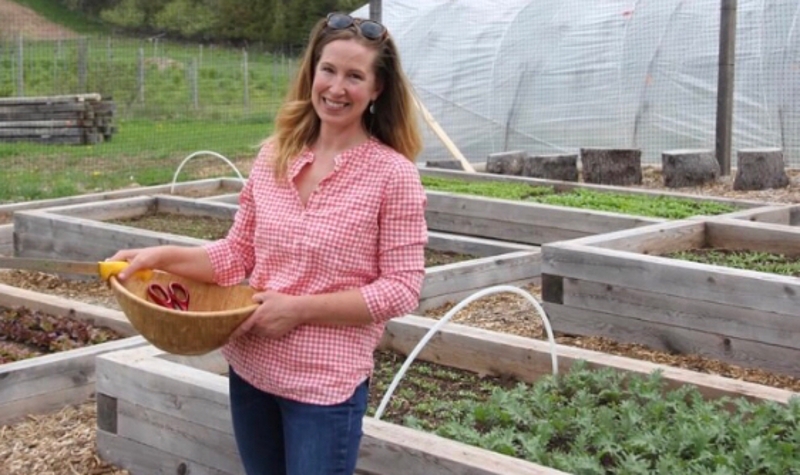Kim Osepchook: Top 5 tips for growing food at home
Author: Kim Osepchook
Posted on Aug 5, 2020
Category: Insights

As the owner and founder of Axil Gardens, UNB alumna Kim Osepchook (BSc'03) has over 15 years of organic gardening experience. Kim's passion is growing beautiful food and she has always firmly believed in using natural and sustainable methods. Located in Quispamsis, NB, Axil Gardens provides culinary and teaching gardens as a space to help clients learn the basics of food gardening. Since 2017, Axil Gardens has been offering children's summer programs, school garden education and edible gardening workshops, but with the changing social atmosphere surrounding COVID-19, switched gears for 2020 to provide virtual and one-on-one home consults (edible garden design and planning,) and online memberships (running from May to September) to help beginning and intermediate local gardeners reach their goals. Axil Gardens also provides a variety of vegetables and herbs to restaurants in the Saint John area, and runs a Community Shared Agriculture (CSA) program for local shareholders.
For the beginning and budding gardener
If you had asked me a year ago what kind of incentive people would require to start a food garden at home, I certainly wouldn’t have thought it would be a global pandemic - but as it turns out, it really was. 2020 has proven to be the year that backyard gardens have made a comeback, and all thanks to COVID-19. In the midst of an unexpected period of isolation, many of us found ourselves with more time on our hands and faced with the realization that certain foods we are accustomed to having readily available were suddenly no longer available (I’m looking at you, bread makers!). With the extra time and our food supply chain in question, many took to the idea of growing food at home - a wise decision for so many reasons. Fresh and nutrient dense foods, mental health, and household food security in particular.
As an agri business with a strong focus on food production and education, there was a steep influx of interest in what services I provide, and many new clients looking to learn and get started on their food gardening projects. For this reason, it has been a surprisingly inspiring time and I am so excited to see more and more home gardens popping up in the community.
For those of you who may still be considering starting a food garden at home - good news, it’s not too late! In fact, fall is the perfect time to design and build your garden so that the work is complete come spring, giving you the jump on the season. I want to share with you my top 5 tips for growing food at home, so whether you are a beginner, or a “budding” gardener, here are some important points to consider:
1. Start small
The best way to learn while enjoying your garden space is to keep it to a manageable size. There is nothing that will deter a new gardener like feeling overwhelmed. A smaller space will be easier to maintain, easier to spot issues if they arise, and will provide the opportunity to learn a little at a time. In turn, you are more likely to enjoy the garden, which is one the most important goals!
2. Choose your location wisely.
You will want easy access to your garden so that you are more likely to visit it for daily maintenance and to easily harvest for the kitchen. If you have kids, try to find a spot that they will also be tempted to check in for fresh garden goods! Also, consider your sunlight exposure. Full sun (6-8 +) hours of direct sun per day will give you more crop options to choose from. For instance, if you only get four hours of direct sun on your space, sun and heat lovers such as tomatoes and cucumbers will not thrive as they would in full sun, so you would be best to plant shade tolerant crops such as lettuce.
3. Understand your soil.
If you are building an in-ground garden, it is important to know what type of soil you are working with. A soil test is a quick and easy way to find out what you will need to amend with to create ideal growing conditions. For example, most crops will be happy with a soil pH between 6.0-6.8, so if your soil is too acidic or too alkaline, it won’t matter how attentive you are to your plants, they will fail to thrive.
4. Research your crops.
It’s important to know a little about your crops before you plant. Each crop has a preferred daytime temperature (some prefer the cooler temperatures of spring and fall, others the full heat of summer); sunlight requirements, an ideal amount of space required in the garden; and even preference to which plants are growing beside them (aka companion planting). Some crop varieties are more suitable to containers, so if you are patio gardening, look for those!
5. Don’t overthink it!
The garden is not meant to be another thing that will make you feel stressed - we have enough of those - it should be created and viewed as a space to slow down, get grounded, nurture and be nurtured. Plant some seeds, be consistent and learn as you grow. If you aren’t sure where to start, ask! You may have friends, relatives, etc who have some gardening experience, and they will likely be very happy to provide insight. If you don’t know who to ask, reach out through my website and I would be happy to help you reach your garden goals.